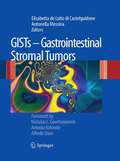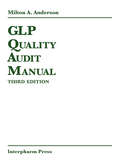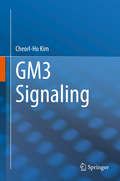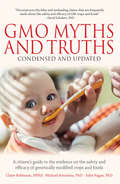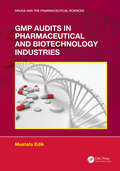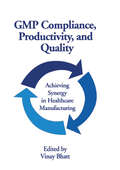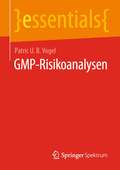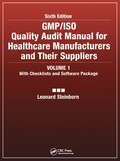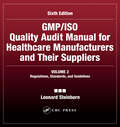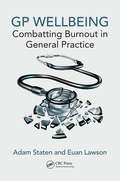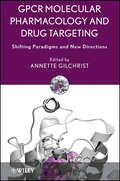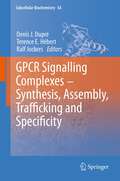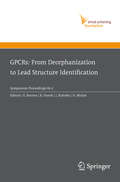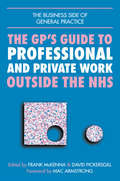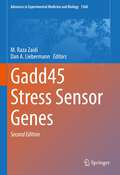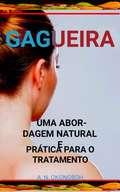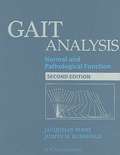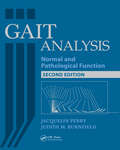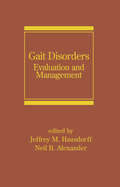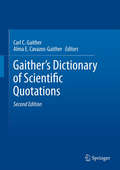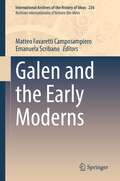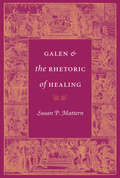- Table View
- List View
GISTs - Gastrointestinal Stromal Tumors
by Antonella Messina Elisabetta de Lutio di CastelguidoneThis book aims to provide a complete overview of the diagnosis and treatment of gastrointestinal stromal tumors (GISTs). It has been conceived to be both a detailed guide for clinical practice and an updated reference for all those involved in the evaluation of GISTs imaging. The publication provides comprehensive descriptions of the full range of common imaging and nonimaging techniques used in the diagnosis and followup of GISTs. Techniques reviewed include: Conventional radiography· Endoscopy and endoscopic ultrasound· Conventional, color-Doppler and contrast-enhanced ultrasound· Computed tomography· Magnetic resonance imaging, and· Contrast-enhanced PET/CT imaging. Both medical and surgical treatment strategies are also fully reviewed. Finally, the book concludes with a chapter that aims to stimulate widespread interest in the formation of new GISTs Units. Written by experts in the field, the book is enriched throughout by numerous black-and-white and color images, making it an invaluable source of information as well as an indispensable guide to interpreting images for radiologists, gastroenterologists, pathologists, oncologists and surgeons.
GLP Quality Audit Manual
by Milton A. AndersonDesigned to enable readers to plan and execute their own audits, this comprehensive guide presents discussions of and practical applications related to establishing a GLP QA unit and performing effective GLP audits. The first section provides the foundation of information needed for designing and initiating a Good Laboratory Practice quality assurance program. Section II contains ready-to-use audit checklists and regulatory references that are in accordance with the most recent regulations. Section Ill comprises the full texts of the relevant standards and regulations along with the Priniciples of Good Laboratory Practice.
GM3 Signaling
by Cheorl-Ho KimThis book reviews recent progress in understanding of the signaling and biochemistry of GM3 ganglioside in eukaryotic cells. GM3 is the simplest of the gangliosides and the precursor of other gangliosides. It is expressed in the outer leaflet of plasma cell membranes and has roles in the recognition, interaction, binding, adhesion, and motility of cells. In addition, GM3 has been documented to have functional roles in cell migration, proliferation, senescence, and apoptosis. The full range of topics of interest are addressed in the book. The early chapters discuss the synthesis of GM3, its molecular localization in cells, and its basic function as an interacting molecule. The ways in which GM3 exerts its effects via various growth factor receptors are fully explored. Current knowledge of the part played by GM3 in health and disease is discussed in depth. For example, its roles in preventing inflammation, inhibiting tumor angiogenesis and tumor growth, and suppressing arthritis are highlighted, and attention drawn to the significance of GM3 as a driver of impaired wound healing in diabetics. The book will be of interest to all who want a comprehensive update on research in this field.
GMO Myths and Truths: A Citizen’s Guide to the Evidence on the Safety and Efficacy of Genetically Modified Crops and Foods, 3rd Edition
by Claire Robinson John Fagan Michael AntoniouIt is often claimed that the case against genetically modified (GM) crops and foods is based on emotion, not science, and that to oppose GM crop and food technology is to be anti-science. It is also claimed that GM crops offer higher yields and better nutrition, that they are safe for health and the environment, that they reduce agrochemical use, and that they are needed to feed the world's growing population. This book, co-authored by two genetic engineers and a writer/researcher, exposes these claims as false, using scientific and other documented evidence. GMO Myths and Truths summarizes the facts on the safety and efficacy of genetically modified (GM) crops and foods in terms that are accessible to the non-scientist but still relevant to scientists, policymakers and educators. The evidence presented points to many hazards, risks, and limitations of genetic engineering technology. These include harms found in animal feeding and ecological studies, which in turn indicate risks to health and the environment posed by GM crops and foods. The layout of the book enables those readers with limited time to read the chapter summaries, while providing more detail and full references for those who require them. At 164 pages of paperback size, this new condensed version is shorter and more accessible than the authors' 330-page report by the same name, which has been downloaded over half a million times. The book shows that conventional breeding continues to outstrip GM in developing crops that deliver high yields, better nutrition, and tolerance to extreme weather conditions and poor soils. In agreement with over 400 international experts who co-authored a UN and World Bank-sponsored report on the future of farming, the authors conclude that modern agroecology, rather than GM, is the best path for feeding the world's current and future populations in a safe and sustainable way.
GMP Audits in Pharmaceutical and Biotechnology Industries (ISSN)
by Mustafa EdikThe fact that good manufacturing practice (GMP) audits in the pharmaceutical and biotechnology industries have to be evaluated, and with very limited resources, has created a gap in this field. The lack of trained and qualified GMP auditors is on the rise in all organizations that are required to implement FDA, EMA, MHRA, WHO, TGA, and PIC/S regulations. This volume is an essential reference source for those organizations operating in the field of health and presents the basic knowledge needed to perform audits. The author also provides useful tips and a selection of samples about GMP audits that are indispensable for professionals and health inspectors working in industry and health authorities.Features An essential reference source for those organizations operating in the field of health and presents the basic knowledge needed to perform audits Anyone working in the manufacturing sector needs to be aware of GMP, be able to identify operational flaws as well as legal violations, and have a clear understanding of how to meet GMP standards Assists readers in understanding the importance of GMP and how they can apply each aspect in their working environment Covers a global regulatory landscape Suitable for relevant degree courses including industrial pharmaceutics and pharmaceutical biotechnology
GMP Compliance, Productivity, and Quality: Achieving Synergy in Healthcare Manufacturing
by Vinay BhattWritten by twenty-eight experts, filled with recommendations that can immediately be put into action, this book provides the strategies and tactics required to link and harmonize manufacturing processes with GMP to achieve optimum operability and cost-effective regulatory compliance. Drawn from name brand and generic companies and regulatory and co
GMP-Risikoanalysen (essentials)
by Patric U. VogelRisikoanalysen sind Methoden des Qualitätsrisikomanagements und nehmen eine wichtige Stellung ein. Der pharmazeutische Prozess umfasst verschiedene Bereiche, u.a. die Produktentwicklung, das regelkonforme Betreiben von Produktionsanlagen, die Beschaffung von Ausgangsmaterialien, die Fertigung von Produktchargen, die Prüfung in der Qualitätskontrolle, die Überwachung der Einhaltung aller Regularien durch die Qualitätssicherung, die Dokumentation und die Bewertung von Auffälligkeiten oder Abweichungen bis hin zur Lagerung und dem Vertrieb der Produkte. Risikoanalysen sind ein essenzielles Werkzeug, das auf alle diese Stufen und Bereiche angewendet wird. Das Ziel ist es Risiken zu identifizieren und zu bewerten, um durch geeignete Maßnahmen das Risiko ausreichend unter Kontrolle zu halten und damit die Produktqualität sicherzustellen.
GMP/ISO Quality Audit Manual for Healthcare Manufacturers and Their Suppliers, (Volume 1 - With Checklists and Software Package): Regulations, Standards, And Guidelines
by Leonard SteinbornVolume 1 of this two-part package provides a complete set of checklists for internal and contract device and drug manufacturers and developers, contract software developers, and suppliers of chemical, printed material, electronic component, and general supplies. It also includes a simulated QSIT audit, and a new-product market launch. All of these
GMP/ISO Quality Audit Manual for Healthcare Manufacturers and Their Suppliers, (Volume 2 - Regulations, Standards, and Guidelines): Regulations, Standards, and Guidelines
by Leonard SteinbornThis well-known QA manual has been updated to provide the guidance readers need to assess their compliance with standard regulations. This Volume 2 of a three-part package contains the full text on: * FDA regulations* EC and IPEC guidelines* ISO/BSI standards referenced in the checklists furnished in volume 1Easy-to-read and organized to provide fa
GP Wellbeing: Combatting Burnout in General Practice
by Adam Staten Euan LawsonThis is the first book to explore the impact of 'burnout' on the current NHS GP workforce and how this can be addressed, from an insider GP perspective. Adam Staten, recently qualified GP, and Euan Lawson, Fellow of the RCGP with over 20 years experience, discuss in engaging, accessible chapters how burnout manifests psychologically, the complex reasons why GPs burn out and the individual and broader impact this can have. Most importantly, the book offers practical advice on how to avoid burning out and combat the negative effects of an increasingly high-pressure role, exploring how GPs can develop resilience and work in a way that builds a healthier work-life balance. A section is dedicated to the array of GP job options, with testimonies from practitioners working in diverse areas from education and academia to military and humanitarian settings. This book explores the challenges of working in general practice today, but it also demonstrates the potential for every GP to experience a personally and professionally satisfying career. Providing practical, workable advice and links to resources for help and support, the book enables readers to find opportunity within the perceived 'crisis'. By reading this book, you will find the means to improve not just your own working life but also to enhance the way you deliver care to your patients.
GPCR Molecular Pharmacology and Drug Targeting
by Annette GilchristG protein-coupled receptors (GPCRs) are a large protein family of transmembrane receptors vital in dictating cellular responses. GPCRs are involved in many diseases, but are also the target of around half of all modern medicinal drugs. Shifting Paradigms in G Protein Coupled Receptors takes a look at the way GPCRs are examined today, how they react, how their mutations lead to disease, and the many ways in which they can be screened for compounds that modulate them. Chemists, pharmacologists, and biologists will find essential information in this comprehensive reference.
GPCR Signalling Complexes – Synthesis, Assembly, Trafficking and Specificity
by Terence E. Hébert Ralf Jockers Denis J. DupréMain Question: G protein coupled receptors are involved in highly efficient and specific activation of signalling pathways. How do GPCR signalling complexes get assembled to generate such specificity? In order to answer this question, we need to understand how receptors and their signalling partners are synthesized, folded and quality-controlled in order to generate functional proteins. Then, we need to understand how each partner of the signalling complex is selected to join a complex, and what makes this assembly possible. GPCRs are known to be able to function as oligomers, what drives the assembly into oligomers and what will be the effects of such organization on specificity and efficacy of signal transduction. Once the receptor complexes are assembled, they need to reach different locations in the cell; what drives and controls the trafficking of GPCR signalling complexes. Finally, defects in synthesis, maturation or trafficking can alter functionality of GPCRs signalling complexes; how can we manipulate the system to make it function normally again? Pharmacological chaperones may just be part of the answer to this question.
GPCRs as Therapeutic Targets
by Annette GilchristA thorough discussion of the structure, pharmacology, function, and role of G protein-coupled receptors In GPCRs as Therapeutic Agents, distinguished researcher Dr. Annette Gilchrist delivers an authoritative and in-depth compendium of a vibrant and active area of academic and industrial drug discovery. The book serves as an important reference for new and experienced researchers studying G protein-coupled receptors and discusses the molecular pharmacology of this important target class. It also includes up-to-date material on GPCR structures and structure-based drug design. The book explores the role of GPCRs in the treatment of disease and novel approaches to their study. In addition to providing information on the structure, pharmacology, and function of GPCRs, it discusses their role in disease states, and advances new methods for measuring GPCR activity in an accessible and engaging way. The book includes: A thorough introduction to the molecular pharmacology of G protein-coupled receptors, including up-to-date material on GPCR structures and structure-based drug design In-depth discussions of the evolving pharmacology for GPCRs, intracellular trafficking, and subcellular GPCR signaling Comprehensive explorations of allosteric modulation, receptor dimerization, deorphanization, and ubiquitination Fulsome treatments of the role played by GPCRs in the treatments of cancer, substance use disorders, cerebrovascular diseases, and metabolic diseasesPerfect for researchers in biochemistry, cell biology, and pharmacology, GPCRs as Therapeutic Agents will also earn a place in the libraries of professionals working in medicinal chemistry, structural biology, and clinical pharmacology.
GPCRs: From Deorphanization to Lead Structure Identification
by H. Bourne J. Kuhnke H. Michel Richard HorukThis book offers an insight into the approaches taken by industry and academia to address GPCRs and depict how mature this target class-oriented research has become in the last decade. Coverage also reflects the actual trends in the fast-emerging field of GPCR research in academia and industry. It is based on the international workshop GPCRs: From Deorphanisation to Lead Structure Identification, held in Berlin in May 2006.
GPs Guide to Professional and Private Work Outside the NHS
by Norman Ellis John LindsayAll GPs undertake the non-NHS work some of which can add substantially to practice income. This book describes a wide range of fee-paying work which GPs are uniquely qualified to undertake; it shows how opportunities for this work arise and how to become involved in it. For many the financial benefits are greatly enhanced by the professional satisfaction such work brings.
GREEN HEALTHCARE INSTITUTIONS Health, Environment, and Economics: WORKSHOP SUMMARY
by Institute of Medicine of the National AcademiesThe National Academies Press (NAP)--publisher for the National Academies--publishes more than 200 books a year offering the most authoritative views, definitive information, and groundbreaking recommendations on a wide range of topics in science, engineering, and health. Our books are unique in that they are authored by the nation's leading experts in every scientific field.
Gadd45 Stress Sensor Genes (Advances in Experimental Medicine and Biology #1360)
by Dan A. Liebermann M. Raza ZaidiThis second edition is fully updated throughout and covers the emerging evidence that indicates that the Gadd45 family of proteins plays a unique and critical role as sensors of stress, including genotoxic, physiological, and oncogenic stress. It sheds light on the complex cellular stress response, encompassing myriad molecular pathways with a plethora of regulators and effectors.The GADD45 stress response genes encode small (18 kd) nuclear/cytoplasmic proteins. These genes are rapidly induced by a wide variety of endogenous and exogenous stress stimuli. Despite marked similarities, Gadd45 genes are regulated differentially and exhibit functional diversity. Gadd45 proteins respond to physiological and oncogenic stress, and are implicated in cell cycle arrest, DNA demethylation and repair, apoptosis, cell survival, genomic stability, and inflammation. The purpose of this book is to provide a comprehensive overview of the unique global role that Gadd45 proteins play as stress sensors and the molecular pathways involved.
Gagueira: uma abordagem natural e prática para o tratamento
by A. N. OkonobohO que é a gagueira? As principais causas da gagueira e como solucionar esses problemas a trevez do controle respiratório e des exercícios de fala. Esses são alguns dos temas a bordados nessa publicação que apresenta a gagueira como a falta de habilidade de coordenar os órgãos responsáveis pela fala. Aléd disso, como os pais, familiares e pessoas próximas desenvolvem um papel importante nesse processo.
Gait Analysis: Normal and Pathological Function
by Jacquelin Perry Judith M. BurnfieldDr. Jacquelin Perry is joined by Dr. Judith Burnfield to present today's latest research findings on human gait. Gait Analysis, Second Edition has been updated and expanded to focus on current research, more sophisticated methods, and the latest equipment available to analyze gait.
Gait Analysis: Normal and Pathological Function
by Jacquelin Perry Judith BurnfieldThe extensive and ground-breaking work of Dr. Jacquelin Perry is encompassed and detailed in the world renowned text, Gait Analysis: Normal and Pathological Function. The medical, healthcare, and rehabilitation professions key text for over 18 years on gait….Now available in a much anticipated New Second EditionDr. Jacquelin Perry is joined by Dr. Judith Burnfield to present today's latest research findings on human gait. Gait Analysis, Second Edition has been updated and expanded to focus on current research, more sophisticated methods, and the latest equipment available to analyze gait.What is New:• A new chapter covering running• Synergy of motion between the two limbs• A new chapter covering pediatrics • A new chapter covering stair negotiation• New and updated clinical examples• A section on power inside each chapter covering normal gait• New methods and equipment to analyze gaitThis Second Edition to Gait Analysis offers a re-organization of the chapters and presentation of material in a more user-friendly, yet comprehensive format. Essential information is provided describing gait functions, and clinical examples to identify and interpret gait deviations. Learning is further reinforced with images and photographs.Features:• Six sections cover the fundamentals, normal gait, pathological gait, clinical considerations, advanced locomotor functions, and gait analysis systems• Clinical significance of the most common pathological gait patterns• Over 470 illustrations and photographs, as well as 40 tables• Patient examples to illustrate elements of normal and pathological gaitTens of thousands of orthopedic, orthotic and prosthetic, physical therapy, and other rehabilitation professionals have kept a copy of Gait Analysis by their side for over 18 years…join the thousands more who will bring the Second Edition into their clinics, classrooms, and personal collections.
Gait Disorders: Evaluation and Management (Neurological Disease and Therapy)
by Jeffrey M. Hausdorff Neil B. AlexanderWith chapters by many of the foremost international authorities on aging, neurology, physical therapy, and rehabilitation, this reference provides an up-to-date review of approaches to gait disorders and falls. This volume presents the fundamental concepts of gait and describes the changes in mobility with aging and disease. A focus is placed on re
Gaither's Dictionary of Scientific Quotations
by Carl C. Gaither Alma E. Cavazos-GaitherThis unprecedented collection of 27,000 quotations is the most comprehensive and carefully researched of its kind, covering all fields of science and mathematics. With this vast compendium you can readily conceptualize and embrace the written images of scientists, laymen, politicians, novelists, playwrights, and poets about humankind's scientific achievements. Approximately 9000 high-quality entries have been added to this new edition to provide a rich selection of quotations for the student, the educator, and the scientist who would like to introduce a presentation with a relevant quotation that provides perspective and historical background on his subject. Gaither's Dictionary of Scientific Quotations, Second Edition, provides the finest reference source of science quotations for all audiences. The new edition adds greater depth to the number of quotations in the various thematic arrangements and also provides new thematic categories.
Galen and the Early Moderns (International Archives of the History of Ideas Archives internationales d'histoire des idées #236)
by Matteo Favaretti Camposampiero Emanuela ScribanoThis book explores the presence of Galen of Pergamon (129 – c. 216 AD) in early modern philosophy, science, and medicine. After a short revival due to the humanistic rediscovery of his works, the influence of the great ancient physician on Western thought seemed to decline rapidly as new discoveries made his anatomy, physiology, and therapeutics more and more obsolete. In fact, even though Galenism was gradually dismissed as a system, several of his ideas spread through the modern world and left their mark on natural philosophy, rational theology, teleology, physiology, biology, botany, and the philosophy of medicine. Without Galen, none of these modern disciplines would have been the same. Linking Renaissance with the Enlightenment, the eleven chapters of this book offer a unique and detailed survey of both scientific and philosophical Galenisms from the sixteenth to the late eighteenth century. Figures discussed include Julius Caesar Scaliger, Giambattista Da Monte, Hyeronimus Fabricius ab Aquapendente, Andrea Cesalpino, Thomas Browne, Kenelm Digby, Henry More, Ralph Cudworth, Robert Boyle, John Locke, Guillaume Lamy, Jean-Baptiste Verduc, Gottfried Wilhelm Leibniz, Christian Wolff, Julien Offray de La Mettrie, Denis Diderot, and Kurt Sprengel.
Galen and the Rhetoric of Healing
by Susan P. MatternGalen is the most important physician of the Roman imperial era. Many of his theories and practices were the basis for medical knowledge for centuries after his death and some practices—like checking a patient’s pulse—are still used today. He also left a vast corpus of writings which makes up a full one-eighth of all surviving ancient Greek literature. Through her readings of hundreds of Galen’s case histories, Susan P. Mattern presents the first systematic investigation of Galen’s clinical practice. Galen’s patient narratives illuminate fascinating interplay among the craft of healing, social class, professional competition, ethnicity, and gender. Mattern describes the public, competitive, and masculine nature of medicine among the urban elite and analyzes the relationship between clinical practice and power in the Roman household. She also finds that although Galen is usually perceived as self-absorbed and self-promoting, his writings reveal him as sensitive to the patient’s history, symptoms, perceptions, and even words. Examining his professional interactions in the context of the world in which he lived and practiced, Galen and the Rhetoric of Healing provides a fresh perspective on a foundational figure in medicine and valuable insight into how doctors thought about their patients and their practice in the ancient world.
Galen and the World of Knowledge
by Christopher Gill Tim Whitmarsh John WilkinsGalen is the most important medical writer in Graeco-Roman antiquity, and also extremely valuable for understanding Graeco-Roman thought and society in the second century AD. This volume of new essays locates him firmly in the intellectual life of his period, and thus aims to make better sense of the medical and philosophical 'world of knowledge' that he tries to create. How did Galen present himself as a reader and an author in comparison with other intellectuals of his day? Above all, how did he fashion himself as a medical practitioner, and how does that self-fashioning relate to the performance culture of second-century Rome? Did he see medicine as taking over some of the traditional roles of philosophy? These and other questions are freshly addressed by leading international experts on Galen and the intellectual life of the period, in a stimulating collection that combines learning with accessibility.
